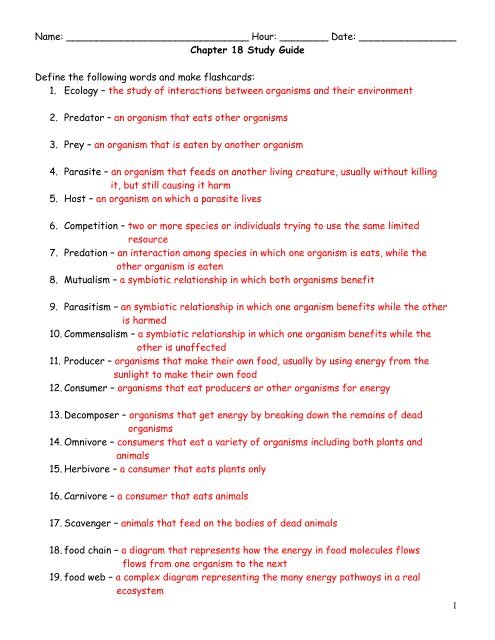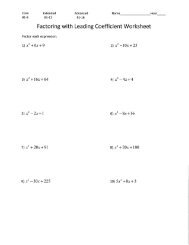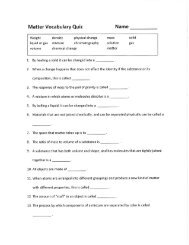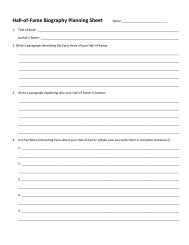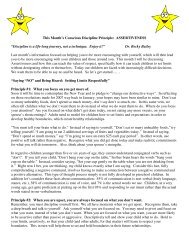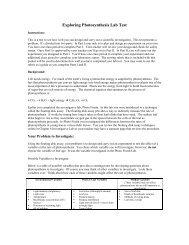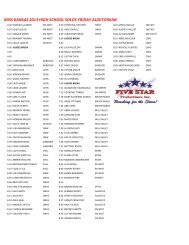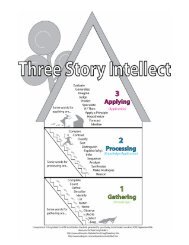Chapter 18 Study Guide
Chapter 18 Study Guide
Chapter 18 Study Guide
- No tags were found...
You also want an ePaper? Increase the reach of your titles
YUMPU automatically turns print PDFs into web optimized ePapers that Google loves.
Name: ______________________________ Hour: ________ Date: ________________<strong>Chapter</strong> <strong>18</strong> <strong>Study</strong> <strong>Guide</strong>Define the following words and make flashcards:1. Ecology – the study of interactions between organisms and their environment2. Predator – an organism that eats other organisms3. Prey – an organism that is eaten by another organism4. Parasite – an organism that feeds on another living creature, usually without killingit, but still causing it harm5. Host – an organism on which a parasite lives6. Competition – two or more species or individuals trying to use the same limitedresource7. Predation – an interaction among species in which one organism is eats, while theother organism is eaten8. Mutualism – a symbiotic relationship in which both organisms benefit9. Parasitism – an symbiotic relationship in which one organism benefits while the otheris harmed10. Commensalism – a symbiotic relationship in which one organism benefits while theother is unaffected11. Producer – organisms that make their own food, usually by using energy from thesunlight to make their own food12. Consumer – organisms that eat producers or other organisms for energy13. Decomposer – organisms that get energy by breaking down the remains of deadorganisms14. Omnivore – consumers that eat a variety of organisms including both plants andanimals15. Herbivore – a consumer that eats plants only16. Carnivore – a consumer that eats animals17. Scavenger – animals that feed on the bodies of dead animals<strong>18</strong>. food chain – a diagram that represents how the energy in food molecules flowsflows from one organism to the next19. food web – a complex diagram representing the many energy pathways in a realecosystem1
Name: ______________________________ Hour: ________ Date: ________________20. energy pyramid – a diagram shaped like a triangle that shows the loss of energy ateach level of the food chain21. habitat – the environment where an organism lives22. niche – an organism’s way of life and it’s relationship with its abiotic and bioticenvironments23. biotic – describes living factors in the environment24. abiotic – describes non-living factors in the environment25. organism – anything that can independently carry out life processes26. population – a group of individuals of the same species that live together in thesame area at the same time27. community – all of the populations of different species that live and interact inan area28. ecosystem – a community of organisms and their non-living environment29. biosphere – the part of the Earth where life exists30. photosynthesis – the process by which plants capture light energy from thesun and convert it into sugar31. limiting factor – a needed resource that is limited in supply32. carrying capacity – the largest population that a given environment can supportover a long period of timeComplete the following statements:33. The largest population of an organism that a given environment can support over time isknown as the environment’s carrying capacity .34. The sun is the source of energy for almost all living things.35. Decomposers are sometimes called nature’s recyclers .36. A symbiotic relationship in which both organisms benefit is calledmutualism .37. A symbiotic relationship in which one organism benefits and the other is unaffected iscalled commensalism .2
Name: ______________________________ Hour: ________ Date: ________________38. A symbiotic relationship in which one organism benefits and the other is harmed iscalled parasitism .39. The greatest amount of energy in an ecosystem is available to the producers .40. Competition exists when 2 or more organisms are in the same area andare trying to use the same resources.41. Energy decreases as you move up an energy pyramid.42. Food webs , food chains , and energy pyramidsrepresent how energy can move through an ecosystem.Answer the following questions:43. What kind of relationship do sharks and remoras have? commensalisms – the remorasbenefit, while the sharks are unaffected44. Place the following terms in the correct order in a food chain.(carnivores, herbivores, scavengers, sun, and producers)sun, producers, herbivores, carnivores, scavengers45. Explain the concept of a niche.describes an organism’s way of life within an environment46. List 3 examples of organisms.possible answers – a dog, a cat, a mouse47. List 3 examples of populations.all the ants of one ant hill, all the people in Olathe, all the rabbits is a forest48. “Birds of a feather flock together” describes which level of environmentalorganization?population – one species living and interacting with one another49. Which levels of environmental organization contain only biotic environments?organism, population, and community50. Which levels of environmental organization contain biotic and abiotic environments?ecosystem and biosphere51. List 3 examples of producers.possible answers - tree, flower, grass52. List 3 examples of herbivores.possible answers – rabbit, deer, antelope53. List 3 examples of omnivores.possible answers – bear, human, monkey54. List 3 examples of carnivores.possible answers – lion, tiger, snake55. List 3 examples of decomposers.possible answers – fungi, bacteria, maggots3


